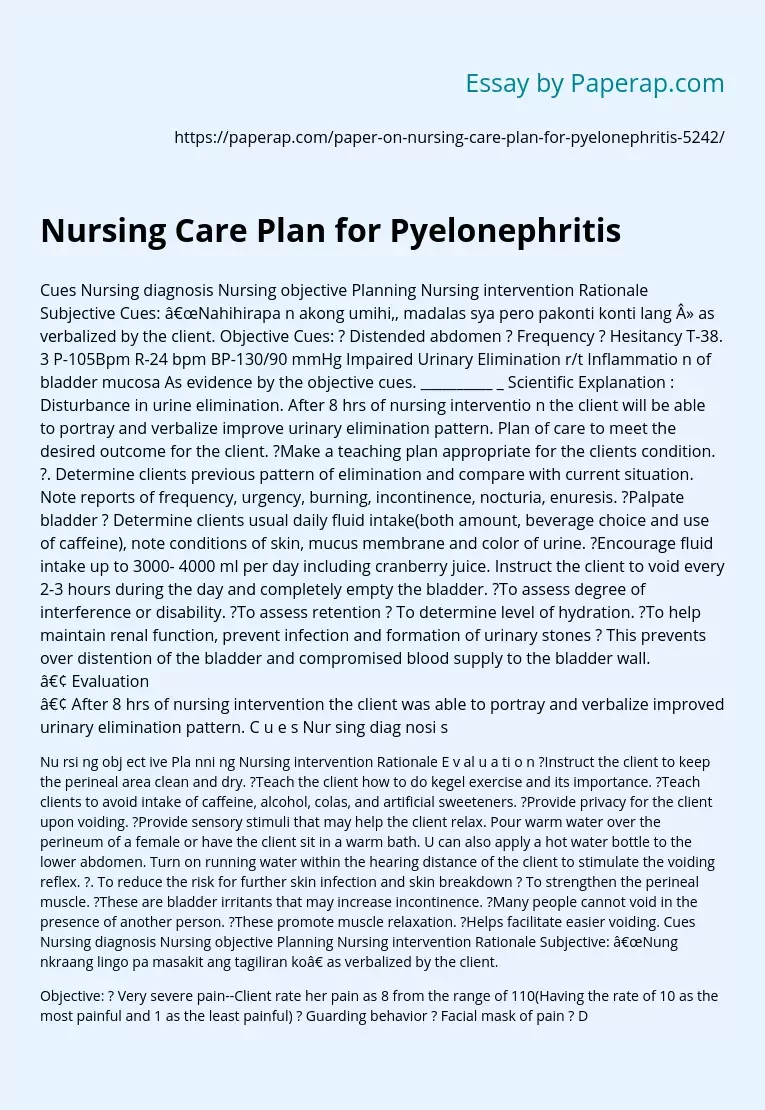Cues Nursing diagnosis Nursing objective Planning Nursing intervention Rationale Subjective Cues: “Nahihirapa n akong umihi,, madalas sya pero pakonti konti lang » as verbalized by the client. Objective Cues: ? Distended abdomen ? Frequency ? Hesitancy T-38. 3 P-105Bpm R-24 bpm BP-130/90 mmHg Impaired Urinary Elimination r/t Inflammatio n of bladder mucosa As evidence by the objective cues. __________ _ Scientific Explanation : Disturbance in urine elimination. After 8 hrs of nursing interventio n the client will be able to portray and verbalize improve urinary elimination pattern. Plan of care to meet the desired outcome for the client.
?Make a teaching plan appropriate for the clients condition. ?. Determine clients previous pattern of elimination and compare with current situation. Note reports of frequency, urgency, burning, incontinence, nocturia, enuresis. ?Palpate bladder ? Determine clients usual daily fluid intake(both amount, beverage choice and use of caffeine), note conditions of skin, mucus membrane and color of urine. ?Encourage fluid intake up to 3000- 4000 ml per day including cranberry juice. Instruct the client to void every 2-3 hours during the day and completely empty the bladder.
?To assess degree of interference or disability. ?To assess retention ? To determine level of hydration. ?To help maintain renal function, prevent infection and formation of urinary stones ? This prevents over distention of the bladder and compromised blood supply to the bladder wall.
• Evaluation
• After 8 hrs of nursing intervention the client was able to portray and verbalize improved urinary elimination pattern. C u e s Nur sing diag nosi s
Nu rsi ng obj ect ive Pla nni ng Nursing intervention Rationale E v al u a ti o n ?Instruct the client to keep the perineal area clean and dry.
?Teach the client how to do kegel exercise and its importance. ?Teach clients to avoid intake of caffeine, alcohol, colas, and artificial sweeteners. ?Provide privacy for the client upon voiding. ?Provide sensory stimuli that may help the client relax. Pour warm water over the perineum of a female or have the client sit in a warm bath. U can also apply a hot water bottle to the lower abdomen. Turn on running water within the hearing distance of the client to stimulate the voiding reflex. ?. To reduce the risk for further skin infection and skin breakdown ? To strengthen the perineal muscle. ?These are bladder irritants that may increase incontinence. ?Many people cannot void in the presence of another person. ?These promote muscle relaxation. ?Helps facilitate easier voiding. Cues Nursing diagnosis Nursing objective Planning Nursing intervention Rationale Subjective: “Nung nkraang lingo pa masakit ang tagiliran ko” as verbalized by the client.
Objective: ? Very severe pain–Client rate her pain as 8 from the range of 110(Having the rate of 10 as the most painful and 1 as the least painful) ? Guarding behavior ? Facial mask of pain ? Diaphoresis T-38. 3 P-105 Bpm R-24 bpm BP-130/90 mmHg Acute pain r/t Acute inflammation of renal tissues as evidenced by verbal reports of pain,guarding behavior and diaphoresis. _______________ Scientific Explanation Unpleasant sensory and emotional experience arising from actual or potential tissue damage.
It is a sudden onset of any intensity from mild to severe with duration of less than 6 months. After 4 hrs of nursing intervent ion the client will be able to verbalize relief of pain from the rate of 8 to at least less than the rate of 4. ?Plan techniques in which the clients level of pain will be alleviated primarily by using of independent nursing interventions. ?Plan with the significant others to cooperate in the pain management program for the client. ?Gather materials that can be helpful in pain management. Perform a comprehensive assessment of pain to include location, characteristics, onset, duration, frequency, quality and severity as well as the precipitating factors ? Encourage patient to verbalize concerns. Actively listen to these concerns and provide support by acceptance, remaining with patient and giving appropriate information. ?Promote quiet environment. ?Identify all stressors and remove it if possible. ?To establish baseline data that will be useful in monitoring improvement in clients’ level of pain. ?Reduction of anxiety or fear that can promote relaxation and comfort. Comfort and quiet environment promote relaxed feeling and permit the client to focus on the relaxation techniques rather than external distraction. ?To be able to lessen factors that could be an aggravating cause in clients’ pain.
• Evaluation: After 4 hrs of nursing intervention the client was able to verbalize relief of pain from the rate of 8 to the rate of 3. Cues Nurs ing diag nosis Nurs ing obje ctive Plan ning Nursing intervention Rationale Ev al ua tio n ?Encourage practice of diversional activities(watching TV, listening to music, reading magazines) ?
Instruct comfort measures such as back rubbing and deep breathing exercise. ?Encourage adequate rest periods. ?To help client shift her focus of attention to other things. ?To reduce muscle tension and promote relaxation. ?To prevent fatigue and prevent further stimulation of pain. Dependent Nursing Management: ? Administer analgesics as prescribed. ?For immediate pain relief . DISCHARGE PLAN
• •
• MEDICATION -Strict compliance to medication regimen -Antibiotics for 7 days (Ceftriaxone 10 mg) EXERCISE/ENVIRONMENT -instruct the client on ways hoe to maintain the cleanliness of her environment.
TREATMENT -practice kegel exercise HEALTH TEACHING -Keep the genital area clean by wiping from front to back, it helps reduce the chance of introducing bacteria from the rectal area to the urethra. -Drink more fluid 64-128 ounces. This encourage frequent urination and flushes bacteria from the bladder. -Encourage proper food handling preparation. -Do handwashing before and after urinate. -Do not delay urination when it is necessary OUT PATIENT FOLLOW UP CARE -Instruct the patient to seek or return upon experience if any sign and symptoms such as severe abdominal pain, fever, painful urination.
• •
Nursing Care Plan for Pyelonephritis. (2018, Feb 09). Retrieved from https://paperap.com/paper-on-nursing-care-plan-for-pyelonephritis-5242/

